现代大学英语精读第二版bookunit
现代大学英语精读3(第二版)Unit12课文翻译及课文知识重点
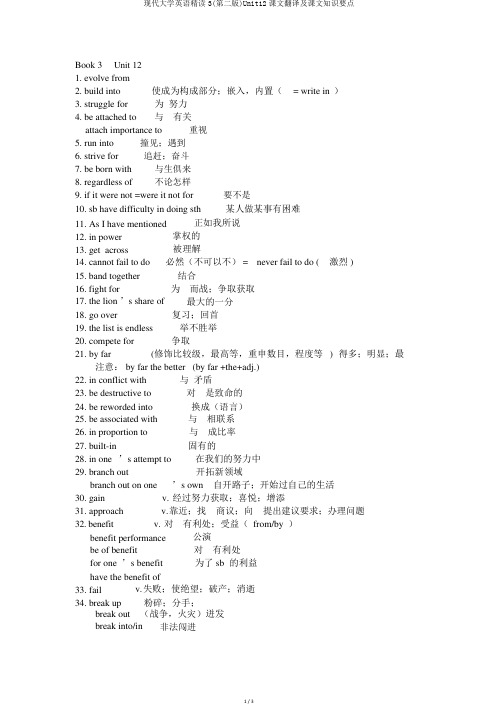
Book 3Unit 121. evolve from2. build into使成为构成部分;嵌入,内置(= write in)3. struggle for为 努力4. be attached to 与 有关attach importance to重视5. run into撞见;遇到6. strive for追赶;奋斗7. be born with与生俱来8. regardless of不论怎样9. if it were not =were it not for要不是10. sb have difficulty in doing sth 某人做某事有困难11. As I have mentioned 正如我所说12. in power 掌权的13. get across 被理解14. cannot fail to do 必然(不可以不) = never fail to do (激烈 )15. band together 结合16. fight for 为 而战;争取获取17. the lion’s share of 最大的一分18. go over 复习;回首19. the list is endless 举不胜举20. compete for 争取21. by far (修饰比较级,最高等,重申数目,程度等 ) 得多;明显;最注意: by far the better (by far +the+adj.)22. in conflict with 与 矛盾23. be destructive to 对 是致命的24. be reworded into 换成(语言)25. be associated with 与 相联系26. in proportion to 与 成比率27. built-in 固有的28. in one’s attempt to 在我们的努力中29. branch out 开拓新领域branch out on one’s own 自开路子;开始过自己的生活30. gain v. 经过努力获取;喜悦;增添31. approach v.靠近;找商议;向提出建议要求;办理问题32. benefit v. 对 有利处;受益( from/by)benefit performance 公演be of benefit 对 有利处for one’s benefit 为了 sb的利益have the benefit of33. fail v.失败;使绝望;破产;消逝34. break up 粉碎;分手;break out (战争,火灾)迸发break into/in非法闯进break through打破,打破,突围35.for the sake of safety 为了安全起见36.call on 呼吁;接见call out 出动,招集;高声叫唤37.stand on the side of 站在 一边;包庇;帮着stand behind做后盾38.get across 超出,渡过(一端到另一端)get through穿过(内部)slip through(从窄缝中)溜过,轻盈地穿过39. look around(round)环视40. in the hope that怀着 希望41. written on被写在 上42. strike out独立闯新路43.contradictory to 与 相矛盾44.share among=divide among 在 之间分派share with sb与 sb 一同分担Translation1.第二次世界大战此后,好多国家一个一个地博得了独立。
现代大学英语精读第二版book2unit8

1
7-28 Astonished
2
29-55 Thrilled
3
56-66 Doubtful
4
67-78 Angry
Text Analysis
Detailed Analysis
Part I(1-6): Main Idea
Why did the narrator want to visit the future? How did the narrator fall into sleep? In what way might visiting the future in sleep be “straight suicide”? What is the narrator’s profession? How do you know? What do people often dream of? Do you have the sense of time in our dreams?
Warming up
Objectives
1. Expand your vocabulary 2. Expand your knowledge of English grammar 3. Understand the structure and the general idea of the story 4. Understand science fiction as a literary genre 5. Learn to appreciate and criticize a text in the framework of the time when it was written 6. Solve your own questions about the story
现代大学英语精读第二版book2unit1分析解析精选课件

Another School Year
Unit 1
Questions / Activities Check-on Preview Objectives
坚持
Warming up
Warming up Questions/Activities
• What do you go to college for? • How has your first semester in university
f_a_c_u_lt_y____ all the teachers of a university or college s_u_ff_ic_e_____ to be enough p_e_n_e_t_ra_t_in_g_ showing the ability to understand things clearly and
deeply s_a_v_a_g_e____ an uncivilized human being l_it_e_r_a_l ____ in a basic meaning of a word c_e_rt_if_y_____ to state something is correct e_n_r_o_ll_____ to officially arrange to join a university
坚持
Warming up Objectives
• Understand the occasion and stylistic features of the speech
• Think about the question of the purpose of university education
getting training for a job in a technical school but doing a B.Sc. at a university.
现代大学英语精读第二版book2unit2学习资料

• B.A. (1972) and M.A. (1975) from Oxford University with First Class Honors in English, a second M.A. from Stanford.
• Born in Alabama USA in 1945. • Parents divorced when he was a
boy; traveled widely with his mother; soon forced to endure life under his strict and cruel stepfather.
much as possible. • Think about the themes of the story and form your
own opinions.
Say Yes
Author
Unit 2
Time
Background
Genre
Culture Tips
Background
His Life
• Non-dramatic, focusing more on the psychological dimensions of a character in dilemmas than on plot development
• Often understated, forcing readers to become engaged in the collection of strands that will result in the full comprehension of a story.
现代大学英语精读第二版book2unit1分析解析精选课件

a child of Italian immigrants Began his career teaching English at the University of
Kansas City Joined the US Air Force in 1942, served as a gunner in
AnAotnhoethr eSrcShcohooloYl eYeaarr–iardi John Ciardi
坚持
Another School Year
Unit 1
Warming up
B ackground T ext Analysis R einforcement
坚持
Warming up Objectives
• Understand the occasion and stylistic features of the speech
• Think about the question of the purpose of university education
literary endeavors.
坚持
Background
His Influence
Poet, translator, etymologist Major works:
现代大学英语精读第二版book2unit9

2021/6/7
14
Background
Author
He concluded the book with:
“War is an invention of the human mind. The human mind can invent peace with justice.”
2021/6/7
15
beings?
2021/6/7
7
Warming up Questions / Activities
• What are the basic lessons of a new education? And what is the importance of such a new education?
2021/6/7
13 Cf. Para. 7
Background
Author
And he continued,
“With such an education and with such self-understanding, it is possible that some nation or people may come forward with the vital inspiration that men need no less than food. Leadership on this higher level does not require mountains of gold or thundering propaganda. It is concerned with human destiny. Human destiny is the issue. People will respond.”
现代大学英语精读第二版Unit

Ethnocentrism
Bentrism? "Ethnic" refers to cultural heritage, and "centrism" refers to the central starting point or the tendency of people to put their own group at the center. "ethnocentrism" basically refers to judging other groups from one’s own cultural point of view, or misinterpreting other cultures because one uses the concepts of his own culture. It is the belief that one particular race or nationality of people is superior to all others.
一位亲眼看见那个妇女被汽车轧过的年轻人同意出庭凭证。我很欣赏他的勇气。
大学教育应该设法保证我们的大学生有进行批判性思维的能力。
College education should see to it that our students are able to do critical thinking.
We at least agree on one thing: We agree not to use force. We agree that we must settle our disputes peacefully.
1
2
3
桂林向来被我们称为最美的地方,我以前怀疑这种说法。现在我完全同意他们了。一切都美极了,尤其是那些千姿百态的石峰。
现代大学英语精读第二UnitSayYes

I. On the Origin of Racism
Debates over the origins of racism often suffer from a lack of _c_la_r_it_y over the term. Many mix recent forms of racism with earlier forms of ethnic and national conflict. In most cases ethno-national conflict seems to _o_w_e_ to conflict over land and strategic resources. In some cases ethnicity and nationalism were _h_ar_n_e_s_s_e_d to wars between great religious empires (for example, the Muslim Turks and the Catholic Austro-Hungarians). As Benedict Anderson has suggested ethnic _id_e_n_t_it_y and ethno-nationalism became a source of conflict within such empires with the rise of print-capitalism.
It don't matter if you're black white or yellow, if your brown or red let's get down to that love is color-blind you're my brother, you're my friend all that matters in the very end is to understand love is color-blind
杨立民《现代大学英语精读(2)》(第2版)学习指南【词汇短语+课文精解+全文翻译+练习答案】

目 录Unit 1一、词汇短语二、课文精解三、全文翻译四、练习答案Unit 2一、词汇短语二、课文精解三、全文翻译四、练习答案Unit 3一、词汇短语二、课文精解三、全文翻译四、练习答案Unit 4一、词汇短语二、课文精解三、全文翻译四、练习答案Unit 5一、词汇短语二、课文精解三、全文翻译四、练习答案Unit 6一、词汇短语二、课文精解三、全文翻译四、练习答案Unit 7一、练习答案Unit 8一、词汇短语二、课文精解三、全文翻译四、练习答案Unit 9一、词汇短语二、课文精解三、全文翻译四、练习答案Unit 10一、词汇短语二、课文精解三、全文翻译四、练习答案Unit 11一、词汇短语二、课文精解三、全文翻译四、练习答案Unit 12一、词汇短语二、课文精解三、全文翻译四、练习答案Unit 13一、词汇短语二、课文精解三、全文翻译四、练习答案Unit 14一、练习答案Unit 15一、词汇短语二、课文精解三、全文翻译四、练习答案Unit 16一、词汇短语二、课文精解三、全文翻译四、练习答案Unit 1一、词汇短语Text Adisaster [di5zB:stE] n.灾难,灾祸;不幸【例句】These difficulties are caused by natural disasters. 这些困难都是由自然灾害造成的。
【助记】dis(不,没有)+aster(星星)→星星消失了,难道预示着灾难的来临?谐音“点扎死他”,灾难。
semester [si5mestE] n.学期;半年【例句】His writing has improved greatly in this semester. 这学期他的写作有了很大进步。
【助记】seme(看作semi半)+s+ ter(看作terra学期)→半学期beanpole [5bi:npEul] n.(插在地上供豆茎攀缘的)支竿,瘦长之人【例句】Li Ling’s elder sister is short and overweight while her younger sister is a beanpole.李玲的姐姐是个矮胖墩儿,可她妹妹却是个细高个儿。
现代大学英语精读第二版book2unit11

Warming up
Warming up
Questions / Activities
“Button, Button”
“Press the button” means to initiate an action or a train of events (informal), often in a nuclear context. The title “Button, Button” indicates taking an action or making a choice that would have consequences.
Background
Author
His Works
A prolific writer: 28 novels, 19 short story collections, 19 movie scripts, and 33 TV screenplays An extended writing career: first short story in 1951, and latest novel in 2011 Author of a list of Times Best Sellers Screenplays and adaptations:
His Life
Born on Feb. 20, 1926 in New Jersey to Norwegian immigrants parents Richard Matheson Raised in Brooklyn, New York (1926-) Served as an infantry soldier in WWII Bachelor in journalism from the University of Missouri in1949 Moved to California in 1951, married in 1952, had four children, three of whom were fiction and screenplay writers
现代大学英语精读第二版book2unit3

Warming up
Check-on Preview
See the Preview Quiz on P67-70.
Warming up
Objectives
• Know something about the author • Understand the genre of essay • Learn how to interpret and appreciate literary essay
4. 5.5 - 7.5. Most plants require ph levels of 6-7, but a few can tolerate 5.5 like corn, carrots, and potatoes. Others can grow well in soil ph of 7.5 like cabbage and cauliflower.
A
Genre Essay
short piece of prose often written from the author’s personal point of view
Vague
definition, great variety: literary, political, academic, journalistic, argumentative, expository, etc.
Objective and factual:
in these essays, the authors "do not speak directly of themselves, but turn their attention outward to some literary or scientific or political theme".
现代大学英语精读第二版UnitUnit句子翻译答案
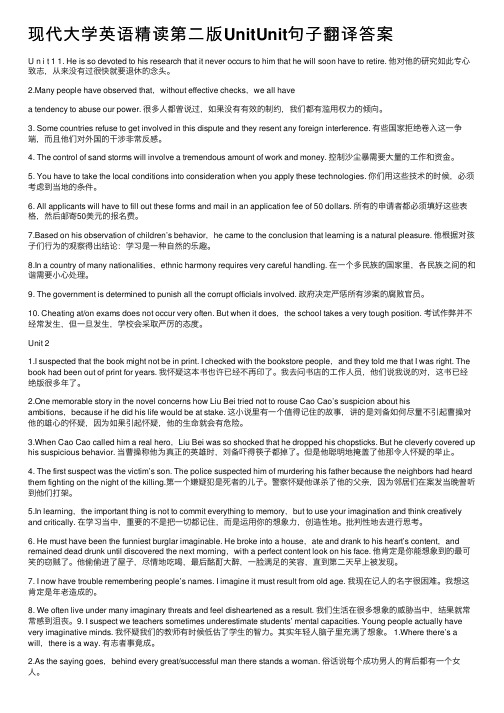
现代⼤学英语精读第⼆版UnitUnit句⼦翻译答案U n i t 1 1. He is so devoted to his research that it never occurs to him that he will soon have to retire. 他对他的研究如此专⼼致志,从来没有过很快就要退休的念头。
2.Many people have observed that,without effective checks,we all havea tendency to abuse our power. 很多⼈都曾说过,如果没有有效的制约,我们都有滥⽤权⼒的倾向。
3. Some countries refuse to get involved in this dispute and they resent any foreign interference. 有些国家拒绝卷⼊这⼀争端,⽽且他们对外国的⼲涉⾮常反感。
4. The control of sand storms will involve a tremendous amount of work and money. 控制沙尘暴需要⼤量的⼯作和资⾦。
5. You have to take the local conditions into consideration when you apply these technologies. 你们⽤这些技术的时候,必须考虑到当地的条件。
6. All applicants will have to fill out these forms and mail in an application fee of 50 dollars. 所有的申请者都必须填好这些表格,然后邮寄50美元的报名费。
7.Based on his observation of children’s behavior,he came to the conclusion that learning is a natural pleasure. 他根据对孩⼦们⾏为的观察得出结论:学习是⼀种⾃然的乐趣。
现代大学英语精读第二版[1].Unit1-16.部分课后练习答案
![现代大学英语精读第二版[1].Unit1-16.部分课后练习答案](https://img.taocdn.com/s3/m/3a273bc376eeaeaad1f330ee.png)
参考答案(Unit 1—8)Unit OneKey to ExercisePreview:Vocabulary4. Complete the sentences by translating the Chinese in the brackets1. differ2. differently, different3. difference4. serious, serious, seriously5. seriousness, seriously polluted6. Fortunately/ Luckily, pollution, seriously, pollute7. attention 8. attentively, attentive5. Fill u in the blanks with the correct prepositions or adverbs1 of2 from3 for4 out5 up6 up7 up for 8. out 9. with 10. of 11. of 12. of 13. upGrammar:3. Fill in the blanks with ONE suitable word.1. easy2. beginning3. But4. suddenly5. worried6. If7. master8. number 9. habit 10. goUnit 2Vocabulary4. Translate the following sentences, paying special attention to the words in bold type.1. 一个男子突然站了起来,用他的鞋子朝他扔过去。
幸亏他及时低头躲了过去。
2. 我们在他回家前把房间通通风吧。
3.她虽然八十好几了,但还能穿针引线。
4. 我们必须勇敢面对这个危险。
总有人妖在我们这里浑水摸鱼。
现代大学英语精读第二版book2unit10

Background
Culture Tips
• Isis is a goddess in Ancient Egyptian religious beliefs. She was worshipped as the ideal mother and wife as well as the patron of nature and magic. She was the friend of slaves, sinners, artisans, and the downtrodden, and she listened to the prayers of the wealthy, maidens, aristocrats, and rulers. Isis is also known as protector of the dead and goddess of children. • The name Isis means "Throne". Her headdress is a throne. As the personification of the throne, she was an important representation of the pharaoh's power. The pharaoh was depicted as her child, who sat on the throne she provided.
Part II: Para. 8-9
Pompeii
Author
Unit 10
Background
Culture Tips
Background
Author
His Life
Robert Silverberg (born January 15, 1935) is an American author, best known for writing science fiction. In 1956 he graduated from Columbia University, having majored in Comparative Literature.
现代大学英语精读第二版bookunitppt课件
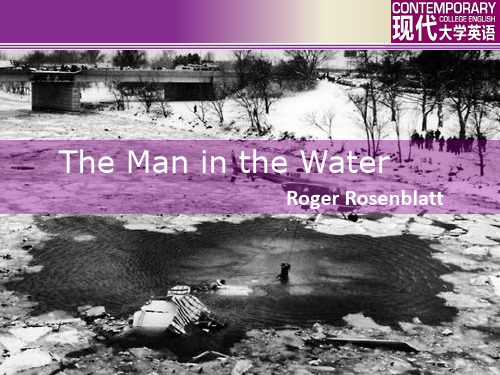
Background
The Man in the Water
• The man was later identified as Arland D. Williams Jr., a bank examiner working for the Federal Reserve system in Atlanta. The 14th Street Bridge was renamed in his honor.
– What does this article concentrate on? Does it focus on the description of the disaster or how people are saved? Why?
Background Category of News
News fall into basic categories: hard news and soft news.
The Man in the Water Unit 4
Questions / Activities Check-on Preview Objectives
Warming up
Warming up Questions / Activities
•Do you know of any disaster(s) that happened in recent years or recently? •When disaster happens, what do we usually want to know? •We sometimes identify some heroes in disasters. What do you think about them?
现代大学英语精读第二版unit课文翻译
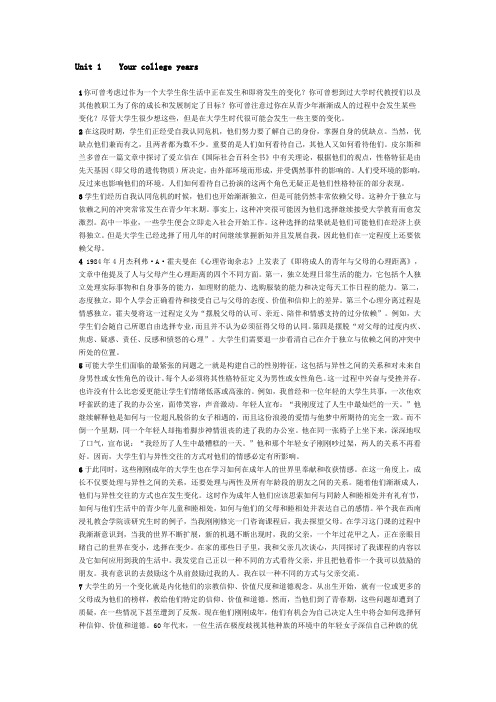
Unit 1 Your college years1你可曾考虑过作为一个大学生你生活中正在发生和即将发生的变化?你可曾想到过大学时代教授们以及其他教职工为了你的成长和发展制定了目标?你可曾注意过你在从青少年渐渐成人的过程中会发生某些变化?尽管大学生很少想这些,但是在大学生时代很可能会发生一些主要的变化。
2在这段时期,学生们正经受自我认同危机,他们努力要了解自己的身份,掌握自身的优缺点。
当然,优缺点他们兼而有之,且两者都为数不少。
重要的是人们如何看待自己,其他人又如何看待他们。
皮尔斯和兰多曾在一篇文章中探讨了爱立信在《国际社会百科全书》中有关理论,根据他们的观点,性格特征是由先天基因(即父母的遗传物质)所决定,由外部环境而形成,并受偶然事件的影响的。
人们受环境的影响,反过来也影响他们的环境。
人们如何看待自己扮演的这两个角色无疑正是他们性格特征的部分表现。
3学生们经历自我认同危机的时候,他们也开始渐渐独立,但是可能仍然非常依赖父母。
这种介于独立与依赖之间的冲突常常发生在青少年末期。
事实上,这种冲突很可能因为他们选择继续接受大学教育而愈发激烈。
高中一毕业,一些学生便会立即走入社会开始工作。
这种选择的结果就是他们可能他们在经济上获得独立。
但是大学生已经选择了用几年的时间继续掌握新知并且发展自我,因此他们在一定程度上还要依赖父母。
4 1984年4月杰利弗·A·霍夫曼在《心理咨询杂志》上发表了《即将成人的青年与父母的心理距离》,文章中他提及了人与父母产生心理距离的四个不同方面。
第一,独立处理日常生活的能力,它包括个人独立处理实际事物和自身事务的能力,如理财的能力、选购服装的能力和决定每天工作日程的能力。
第二,态度独立,即个人学会正确看待和接受自己与父母的态度、价值和信仰上的差异。
第三个心理分离过程是情感独立,霍夫曼将这一过程定义为“摆脱父母的认可、亲近、陪伴和情感支持的过分依赖”。
例如,大学生们会随自己所愿自由选择专业,而且并不认为必须征得父母的认同。
现代大学英语精读第二版book2unit4

1. aesthetic 2. chaotic 3. commitment 4. standoff 5. impact
a. a determination to do what one considers to be his duty b. being central or most important c. a situation in which neither side in a fight can gain an advantage d. the force of one object striking or hitting another e. concerning beauty, esp. beauty in art f. a stop or pause
“the sixth man”, “the man in the water”
Backgrou nd
The Man in the Water
"He was about 50 years old, one of half a dozen survivors clinging to twisted wreckage bobbing in the icy Potomac when the first helicopter arrived. To the copter's two-man Park Police crew he seemed the most alert. Life vests were dropped, then a flotation ball. The man passed them to the others. On two occasions, the crew recalled last night, he handed away a life line from the hovering machine that could have dragged him to safety. … and the helicopter pilot, Donald W. Usher, returned to the scene, but the man was gone."
现代大学英语精读第二版第二册课后练习题答案
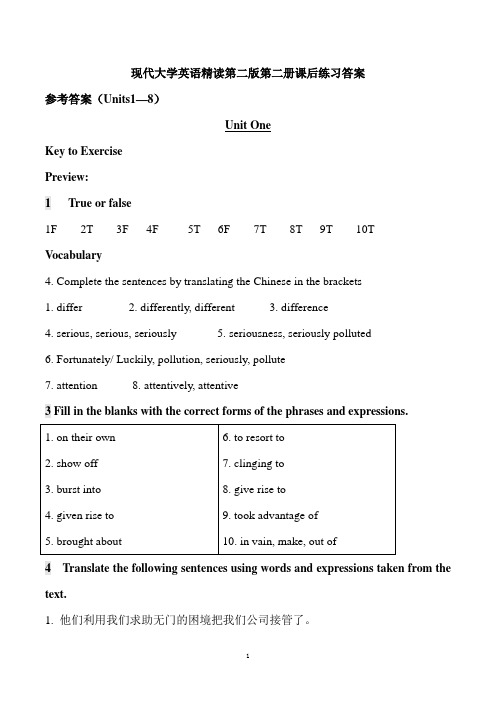
现代大学英语精读第二版第二册课后练习答案参考答案(Units1—8)Unit OneKey to ExercisePreview:1 True or false1F 2T 3F 4F 5T 6F 7T 8T 9T 10TVocabulary4. Complete the sentences by translating the Chinese in the brackets1. differ2. differently, different3. difference4. serious, serious, seriously5. seriousness, seriously polluted6. Fortunately/ Luckily, pollution, seriously, pollute7. attention 8. attentively, attentive3 Fill in the blanks with the correct forms of the phrases and expressions.4 Translate the following sentences using words and expressions taken from the text.1. 他们利用我们求助无门的困境把我们公司接管了。
They took advantage of our helpless situation and took over our company.2. 虽然我们面前仍有困难,但我肯定我们中国人有智慧靠自己实现国家的和平统一。
Although there are still difficulties ahead of us, I am sure that we Chinese people will have the wisdom to bring abou t the peaceful unification of our country on our own.3. 只强调国内生产总值是错误的,它会引起很多严重问题。
现代大学英语精读第二版book2unit4课件

;
No one reaches out a
for you to hold
You can find love if you
within yourself
And the emptiness you felt will
;
And then a hero comes along
With the strength to carry on
that a hero lies in you......!
WB T L E
The end of Sing a song.
PPT学习交流
Lesson 6 – The Man in the Water
7
Lesson 6 – The Man in the Water
II. Sing a song.
It's a long road when you face the world
;
So when you feel like
is gone
Look inside you and be
;
And you'll finally see the
that a hero lies in you
WB T L E
To be continued on the next page.
PPT学习交流
6
WB T L E
To be continued on the next page.
PPT学习交流
8
The Man in the Water Unit 4
The Disaster
Background Washington DC
Genre
PPT学习交流
- 1、下载文档前请自行甄别文档内容的完整性,平台不提供额外的编辑、内容补充、找答案等附加服务。
- 2、"仅部分预览"的文档,不可在线预览部分如存在完整性等问题,可反馈申请退款(可完整预览的文档不适用该条件!)。
- 3、如文档侵犯您的权益,请联系客服反馈,我们会尽快为您处理(人工客服工作时间:9:00-18:30)。
• “Hard news” includes stories of a timely nature about events or conflicts that have just happened or are about to happen, such as crimes, fires, meetings, protest rallies, speeches and testimony in court cases.
The Man in the Water Unit 4
Theme
Structure
Detailed Analysis
Text Analysis
Text Analysis Theme
What are the possible themes of the article? • heroism • moral power in time of crisis
BackgroBiblioteka ndThe Disaster
WB TR
Background
The Disaster
Summary of the crash
• Bad weather conditions at Washington National Airport when taking off
• Delays, icing on the wings, poor decisions • Crash onto the 14th Street Bridge • Hampered rescue responses • Unlikely heroes
• “the sixth man”, “the man in the water”
Background
The Man in the Water
"He was about 50 years old, one of half a dozen survivors clinging to twisted wreckage bobbing in the icy Potomac when the first helicopter arrived. To the copter's two-man Park Police crew he seemed the most alert. Life vests were dropped, then a flotation ball. The man passed them to the others. On two occasions, the crew recalled last night, he handed away a life line from the hovering machine that could have dragged him to safety. … and the helicopter pilot, Donald W. Usher, returned to the scene, but the man was gone."
Warming up Objectives
Through this lesson, students will • be able to recap the basic facts of the plane crush and the following rescue efforts, esp. what the man in the water did; • think about the question of heroism and the power of man; • analyze the organization and the language style of the text; • learn the related vocabulary and other useful words and phrases in the text.
Language Style
Journalistic articles: describe the fact with what is seen or heard; sometimes guesses are made, but often with model verbs and continuous tenses to make the description reliable and vivid. Parentheses and short elliptical sentences to make the report vivid.
• These stories have immediacy.
• “Soft news” is defined as news that entertains or informs, with an emphasis on human interest(人情味) and novelty(新奇) and less immediacy than hard news.
The Man in the Water
Roger Rosenblatt
The Man in the Water Unit 4
W arming up B ackground T ext Analysis R einforcement
The Man in the Water Unit 4
Questions / Activities Check-on Preview Objectives
Part II: Para. 3-4
• The account given by the living heroes about what happened and about “the man in the water”.
Background
News Feature
• A news feature does not cover all the details a news report has to contain and only focuses on certain aspects of the event on which the reporter has something to say. Though the details about the news event have to be true and exact, the reporter can add his/her own comment and interpretation of the event, which he/she is not allowed in a news report.
Background
The Man in the Water
• The man was later identified as Arland D. Williams Jr., a bank examiner working for the Federal Reserve system in Atlanta. The 14th Street Bridge was renamed in his honor.
Warming up
Warming up Questions / Activities
•Do you know of any disaster(s) that happened in recent years or recently? •When disaster happens, what do we usually want to know? •We sometimes identify some heroes in disasters. What do you think about them?
The Man in the Water Unit 4
The Disaster
Background
Genre
Background
The Disaster
Aircraft type: Boeing 737-222 Operator: Air Florida Passengers: 74 Crew: 5 Date: January 13, 1982 Type: Crash on takeoff Accident site: Washington, D.C. Fatalities: 78 (4 on ground) Injuries: 10 Survivors: 5
• “Soft news” can also be stories that focus on people, places or issues that affect readers’ lives. These types of stories are called“feature stories.”
Background
Which category do these fall into?
• flash (快讯) • features (特写) • urgent (急电) • anecdote (趣事;轶事) • brief (简讯) • personal profile (人物特写) • breaking news (突发新闻)
Background The Rescue Site
The Disaster
Background
Responses in the media
• News media outlets followed the story with diligence; it made headlines
• "A Hero - Passenger Aids Others, Then Dies," Washington Post, January 14, 1982
Warming up Check-on Preview
• Match the words with their correct meaning in the text.
